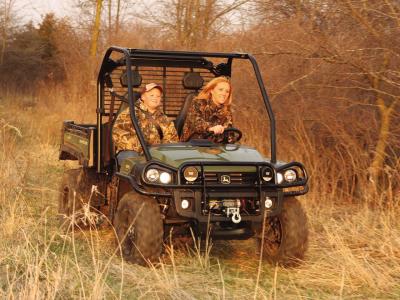 When most people think of John Deere, it has little to do with off-road vehicles and everything to do with American agriculture. There’s more than one side to a field, however, and the company that began with old John Deere’s simple steel plow, pounded into shape from a broken saw blade, has turned into one of the world’s most recognizable brands, with products that touch on nearly every type of outdoor activity whether it’s work or recreation. Deere & Co. has always remained true to its down-on-the-farm roots, though, and one of their most successful products began as an incredibly handy utility vehicle named after a southern swamp predator.
When most people think of John Deere, it has little to do with off-road vehicles and everything to do with American agriculture. There’s more than one side to a field, however, and the company that began with old John Deere’s simple steel plow, pounded into shape from a broken saw blade, has turned into one of the world’s most recognizable brands, with products that touch on nearly every type of outdoor activity whether it’s work or recreation. Deere & Co. has always remained true to its down-on-the-farm roots, though, and one of their most successful products began as an incredibly handy utility vehicle named after a southern swamp predator.
Deere’s original utility vehicle, the single seat AMT, was for all intents and purposes a mechanized ranch hand, with the ability to carry a load, run errands, and a thousand other jobs around the farm. Before long it evolved into the Gator -and Deere sold boatloads of them. Other companies took notice as well and Polaris introduced their Ranger aimed squarely at hunters and sportsmen, and Yamaha jumped on the performance aspect with their Rhino. Customers were looking for the ability to both work and play, and the Gator was soon to receive another round of updates to make it more trail friendly.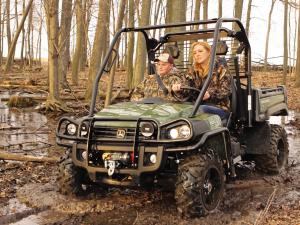
Gator Evolution – The 825i
The new Gator 825i can handle any tough job during the week, but there is no reason to leave it in the barn on the weekend; it’s ready for adventure as well. The beefy chassis is designed for years of abuse, but it also offers more suspension travel and ground clearance than any other Gator. Dual A-arms are used at both ends with the front wheels featuring 8 inches of travel, and 9 inches at the rear. Lightweight and super tough, cast aluminum wheels are shod with Maxxis Bighorn 2.0 tires, and we’ve found them to be extremely durable and excellent in every terrain from rocks to snow. Five way, preload adjustable shocks do a good job of smoothing out the trail and can be adjusted for recreation or heavy hauling.
Farm work is never done. Deere gave the Gator a 2 inch receiver hitch at BOTH ends because a front hitch comes in very handy when maneuvering wagons or trailers. A recessed winch location makes mounting a plow easier, and integrated rear bumper lights come in handy for any work after dark. At the front, the 825i has enough lights for an airplane, and there is room for more on the cool looking, heavy duty bumper. Perhaps the best thing about the Gator chassis, however, is that it is triple certified as a Roll Over Protection structure or ROPS for short. Underneath, the chassis is well protected and rather than plastic skid plates, the Gator gets real protection with a steel plate. This does add weight and cost a little power, but where the Gator is likely going, the extra protection is well worth having.
Green Power
The new Gator 825i is unlike any other UTV in that it comes with a very unique motor. The 825i is powered by a DOHC, liquid cooled, triple cylinder engine with EFI and if that isn’t unusual enough, it has three valves per cylinder! The engine is also used in a car from India, but it was built to Deere specs for the rigors of UTV use and it cranks out a healthy 50hp, which is enough to be considered a New Delhi muscle car. Mated to the engine is a traditional CVT transmission with Low, High, Neutral and Reverse.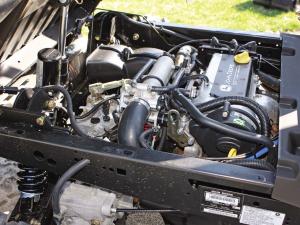
Access to the engine is excellent when the rear dump box is raised, and we love the oil fill and dip stick locations. There’s no reason not to do oil checks on this machine! The air filter is super easy to remove just to the right of the passenger seat, but it does seem a little on the small side for a 50hp engine that is likely to be operated in lots of dust and dirt. Also, the CVT air intake is just under the driver’s seat, and we’re a little concerned because both air intakes are mounted rather low in the chassis on a machine that will be fording muddy ponds, creeks, and fields on a regular basis. Relocating both intakes higher in the chassis would make us feel a LOT better! Another huge plus for the Gator is that underneath the passenger seat is a full-sized 12 volt battery instead of a wimpy motorcycle battery.
New Body
A new 825i wouldn’t be complete without major changes to the bodywork and cab. With its headlights tucked safely inside the front cowling and behind the massive bumper, the 825i sports a tough, menacing look. Control layout is simple to understand with very high quality switches for lights and accessories, and an EXCELLENT digital display. Deere’s digital display is the best in the sport, and we like how the main numbers are very large and easy to read while underway which is extremely important when working at tasks that require precise speeds such as spraying crops, applying fertilizer, or spreading seed. Nice job! The display also offers an assortment of warning indicators for temperature, parking brake engagement, seatbelts, battery power, as well as a clock, trip meter, rpm, 4wd, etc. Curiously, the display is even equipped for blinkers and an electronic fuel gauge, but the Gator features neither. The new steering wheel of the Gator is comfortable but does not offer tilt steering.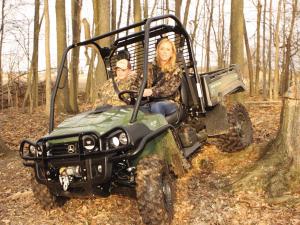
The Gator 825i offers a couple seating options in step with its sportier side and can be had with high back bucket seats, a lower bucket seat, or a semi bench style configuration. Three point seatbelts hold you in place and a warning on the dash lights up if you drive away without them engaged. Between the seats the gear shift lever, differential lock, and parking brake lever are found. Thankfully, the parking brake also has an alarm with a pitch high enough to make dogs run away and it immediately barks out if you try to drive off with it engaged. You’re right, we’ve made that mistake! A passenger in the 825i will also find two handholds, the first on the roll structure, and the second just below the open dash storage. Between the two occupants is a pair of cup holders.
Storage is very important on any utility vehicle, and Deere made definite improvements with three different compartments. Under the front hood is a nice storage area, between the two seats is a handy box for your cell phone, maps, a gps, etc and it even has it’s own power outlet, and on the dash is an open storage bin. It’s a huge improvement and you can never have too much room for tools, tie downs, tire sealant, and a hundred other items we always find a need for.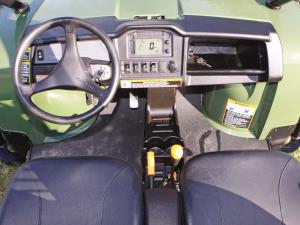
Big Green Box
The Gator has always been a reliable work horse with a cargo box ready to carry anything you can pile in it. Rather than the steel box of the past, however, the new 825i gets a huge, super tough, composite box with a steel bottom, removable sides, and 1000lb capacity. Inside the box the deck can be had in painted steel or with a durable spray-on bed liner which also helps keep loose loads from rattling around, making the melodious mechanical cacophony of rocks in a cement mixer. We like the new box styling; it not only looks great but is functional as well, and there are internal tie down loops and a sturdy top rail. Deere claims 21 tie down points; we can probably find more! At the rear of the box is a smooth working tail gate and somebody at Deere engineering needs a medal for their stroke of genius. Inside the tailgate they’ve molded in a 44 inch ruler for quick measurements on lumber to be cut, or antler spread if you’re lucky! Clearly, they were building a backyard deck at the time, and we love it! Another great feature is the comfortable handholds molded into the bottom of the box for easy lifting with the gas assist shock, although our model featured the optional electric power lift. Either way the box lifts high enough to dump any load cleanly. We also really like the protective screen between the cab area and the cargo box which keeps the occupants and load safely separated.
Deere in the Woods
We were excited to get the new 825i out on the trails and to put it to work! The first thing we noticed is the high back bucket seats are very comfortable, and the three point belts hold you in place but don’t exhibit that annoying habit of constantly ratcheting themselves tighter with each bump of the trail as is common to a couple other models. After all, we’re going to the woods, not into space. Down below the pedal angles are both comfortable and easy to hold steady, with good response and feel from both the throttle and the brake.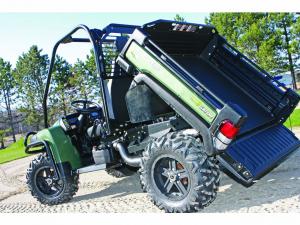
A twist of the key brought the Deere engine to life. Curiously, it can only be started in neutral but does not require the brake to be pressed. However, unlike the other bad habits you’ve spent a lifetime cultivating as if they were roses in the White House garden and you were the head caretaker, holding the brake on startup of any vehicle is a habit you should form. The sound from the Deere engine is unlike any other UTV, and when 3 cylinders and 12 valves begin their mechanical symphony, it’s almost diesel-like in the exhaust note. It sounds powerful, and with 50hp it certainly ranks at the top of the class.
On the trail, the engine easily pulls the Gator along with authority thanks to enormous torque from the engine, and although it gets up to speed rather quickly, it doesn’t have a hard, jerky hit in the powerband. The engine pulls steadily to 6000 rpm where it hits the rev limiter for a top speed of 44 mph and it’s happy to remain there for as long as you want. At speed the Gator is extremely stable and predictable with no tendency to wander, and on uneven terrain or slopes, it feels very safe thanks to a wide footprint and low center of mass. It’s confidence inspiring! Even with a wider overall width, the turning radius is respectable, although we wish the steering gear ratio was a little more aggressive. When winding between tight trees, you’ll find yourself doing a lot of steering for actual wheel movement, and power steering or a tighter steering rack ratio could fix this on future models. The Maxxis tires hook up very well on just about every type of terrain, and it’s been our experience they are very resistant to punctures. A rear swaybar limits body roll and helps the Gator stay flat in turns. For towing a load, the beefy chassis and hitch are up to just about any challenge, and the Gator will tow 1500 pounds with a total load carrying capacity of 1400 pounds. Getting a load moving is only half the battle, however, and just as important is the ability to stop. Response from the redesigned hydraulic disc brakes is excellent with good pedal feel, and brake bias from front to rear seems well proportioned.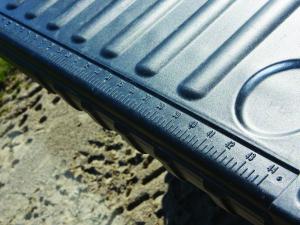
Suspension is plush over choppy, rutted terrain and overall it feels solid. At times we could feel tires flex which would give a mushy feeling in the steering wheel, but it does track well and doesn’t seem to dart around when crossing ruts. With 4wd engaged it does steer slightly harder, and once again power steering would change this. Shifting between gears is vastly improved. It goes from forward to reverse gears easily and smoothly, and although it’s not Kawasaki transmission smooth, it’s better than the Polaris tranny.
New Generation Gator Wish List
As much as we like the new Gator 825i, there are a few things we feel could make it even better and it’s our job to let you know what to expect. Besides our constant nagging, begging, and cajoling for additional storage, all of our suggestions would directly affect driver and passenger comfort.
The first thing we would do is try to reduce exhaust noise. The Gator is a little louder than many other UTVs, and the constant drone from the engine can get a little annoying. There are several factors that impact noise feedback such as muffler design, reflected noise off the cargo box, and even induction noise from the air intake tract, and reducing the noise would be a major improvement. The second change we would make is to improve driver and passenger splash protection, not from the front wheels, but from the back. Under both seats the area to the rear tire is essentially open, which allows the rear tires to fling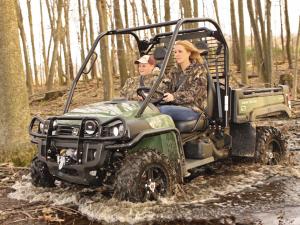 mud or splash water back onto the occupant’s lower legs and feet. The Gator seriously needs a shield behind the seats, and a secondary benefit would likely be reduced engine noise as well. We would also enlarge and raise the sidebar to both seats. The Gator now invites aggressive driving, yet the seats only have a small, low side rail between the occupants and anything passing by, including the ground. We know the current low side rail makes for easier entry, but it’s more important to keep the occupants inside the vehicle than out. We would also LOVE to change how the front wheel well intrudes on both the driver and passenger foot area. Unless you’re an eye patch sporting, peg-legged pirate, you’ll quickly discover exactly what we mean and more than likely come to love the intrusion just as much as we do. Finally, we feel a digital fuel gauge should be standard, especially since it comes standard on nearly every competing model, and the digital readout is already designed for it.
mud or splash water back onto the occupant’s lower legs and feet. The Gator seriously needs a shield behind the seats, and a secondary benefit would likely be reduced engine noise as well. We would also enlarge and raise the sidebar to both seats. The Gator now invites aggressive driving, yet the seats only have a small, low side rail between the occupants and anything passing by, including the ground. We know the current low side rail makes for easier entry, but it’s more important to keep the occupants inside the vehicle than out. We would also LOVE to change how the front wheel well intrudes on both the driver and passenger foot area. Unless you’re an eye patch sporting, peg-legged pirate, you’ll quickly discover exactly what we mean and more than likely come to love the intrusion just as much as we do. Finally, we feel a digital fuel gauge should be standard, especially since it comes standard on nearly every competing model, and the digital readout is already designed for it.
Nothing Runs Like a Deere
The saying is, “Nothing Runs Like a Deere,” and the Gators have always run, and run and run seemingly forever with no more care than the proverbial government mule. We’ve seen them patched up with everything from duct tape to JB weld, and they’re still in the field toiling away. The new Gator 825i is an entirely different animal, though. The 825i is well built with excellent attention to detail and it certainly lives up to the hard working heritage. However, it must also now meet a much higher standard for off-road performance as well, and it’s off to a very good start. Then again, isn’t that what evolution is all about?
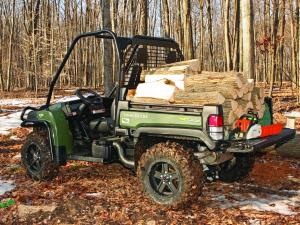 |
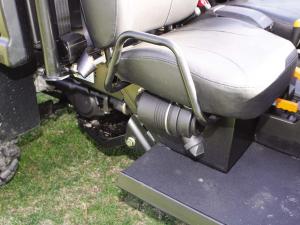 |
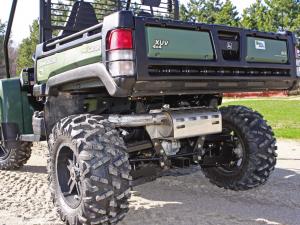 |
| Width | 62 in. (1571 mm) |
| Height (with OPS) | 75 in. (1903 mm) |
| Weight (dry weight) | 1630 lb. (739 kg) |
| Towing Capacity | 1,500 lb. (680 kg) |
| Payload Capacity | 1400 lb. (635 kg) |
| Cargo Box Capacity / Dimensions, in. (mm) | 45 x12 x52, |
| Weight | 1000 lb. (454 kg) |
| Front Tires | Maxxis Big Horn 2.0, Radial 27x9xR14 |
| Rear Tires | Maxxis Big Horn 2.0, Radial 27x11xR14 |
| Engine | Liquid cooled, 3 cylinder 4-cycle gas, Electronic Fuel Injection (EFI), 4 valves per cyl. |
| Horsepower* | 50 (37.28 kW)* 23 (17.2 kW)* 25 (18.6 kW)* |
| Battery | 340CCA 340CCA 480CCA |
| Alternator | 75 amp @ 6000 rpm, |
| Headlights | Two 27 watt halogen Two 27 watt halogen Two 27 watt halogen |
| Transmission Type | Continuously Variable Transmission (CVT) with full clutch enclosure, On-demand true 4WD system |
| Front Differential | Auto-locking |
| Rear Differential | Positive locking, mechanically actuated |
| Front/Rear Brakes | Hydraulic disc with twin piston front calipers |
| Park brake | Driveline, internal wet multi-disc |
| Front and Rear Suspension | Fully Independent dual control A-arm with adjustable spring preload |
| Front Suspension Travel | 8 in. (203 mm) |








